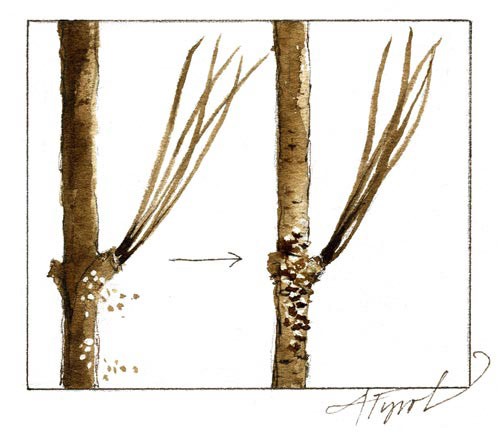
If you’re a white pine, it can’t be a good way to die.
It starts when infectious spores land on your needles and enter through your pores. Masses of slimy spores grow under your bark, rupturing it. The disease oozes down your branch to your trunk, where it slowly strangles you. The process can take years.
This killer is white pine blister rust – Cronartium ribicola. But the killer fungal spores don’t come from other white pines; they come from infected currant or gooseberry bushes in the genus Ribes. The white pine blister rust is like malaria – it needs an alternate host to complete its lifecycle. Especially vulnerable are young pines; older ones less so. The rust affects Ribes plants as well, and can be spread from one Ribes bush to another.
An East Asia native, the blister rust came to the U.S. on infected pine seedlings in the late 1800s, and soon infected Ribes plants and then our native white pines. By 1911, it was found throughout the Northeast. In 1917, New Hampshire prohibited the sale or planting of Ribes species and began eradication programs. In 1920, the federal government ordered a plant quarantine, prohibiting the importation or cultivation of all Ribes. Other states enacted their own laws. The Depression-era Civilian Conservation Corps fielded an army of thousands to hunt down the plants and kill them.
The disease was never eradicated, but the campaign against Ribes cut the incidence of it considerably. Many states stopped enforcing their laws, rescinded them, or modified them. The federal ban on Ribes was rescinded in 1966. Plant breeders developed rust-resistant varieties of Ribes and states came under increasing pressure from berry growers and nursery workers for permission to plant them.
Today, despite calls for Ribes restrictions from forestry types, Vermont has no Ribes ban, said Tim Schmalz, a plant pathologist with the Vermont Agency of Agriculture. The rust is present in Vermont; Schmalz sees it in his own woods.
New Hampshire relaxed its ban beginning in 1999, allowing the planting (with a permit) of 19 resistant gooseberry and currant cultivars, including a large-fruited, tasty currant called Titania, which the New Hampshire Division of Forests and Lands’ own literature touted as “the best one to plant.”
“We were going by the research and believing we could trust it,” said Jennifer Weimer, a forest health specialist with the Division’s Forest Health Section.
But in 2011, Connecticut researchers announced that white pine blister rust had been confirmed in a large planting of Titania currants in that state. New Hampshire forest pathologists took to the field to test plantings. Of 23 sites surveyed, nine were loaded with rust on Titania and other supposedly resistant cultivars; rust was also found on pines nearby. New Hampshire imposed a moratorium on new plantings of Ribes. There are plans for an extended survey of existing plantings.
The larger question is whether there is any guarantee of immunity or resistance to this fungus.
Isabel Munck, a forest pathologist for the US Forest Service, said that growers trying to breed for resistance often work with only a few strains of a fungus, and they might not be the strains the plant is exposed to in the real world. “The situation is different when you have a plant outside, exposed to many more strains of a fungus,” she said.
In contrast to New Hampshire, Maine never let down its guard.
William Ostrofsky, a forest pathologist with the Maine Forest Service, said every time would-be growers pushed to be able to grow currants and gooseberries, forestry officials strongly opposed it, arguing the Pine Tree State’s pines were just too valuable to risk for a few berries.
Especially worrisome, Ostrofsky said, is the fact that all the Ribes cultivars touted as resistant had in their ancestry the European blackcurrant, which, when infected, produces huge numbers of spores. The fear was that birds would scatter the berries and that increased susceptibility to the fungus would find its way into the native Ribes species, he said.
Ostrofsky believes the white pine blister rust fungus mutated. There’s always the likelihood, he said, that some spores are going to be successful in infecting a supposedly resistant plant, and over time a new strain of the disease will be born.
Of course, trying to reinstitute a Ribes ban is like trying to put a genie back into his bottle.
Weimer said it will probably take a couple more years of research to assess the extent of the outbreak in New Hampshire. “The potential is there for it to be a problem. We have to determine if it’s really an issue. We have a lot of questions to answer,” she said.


Discussion *